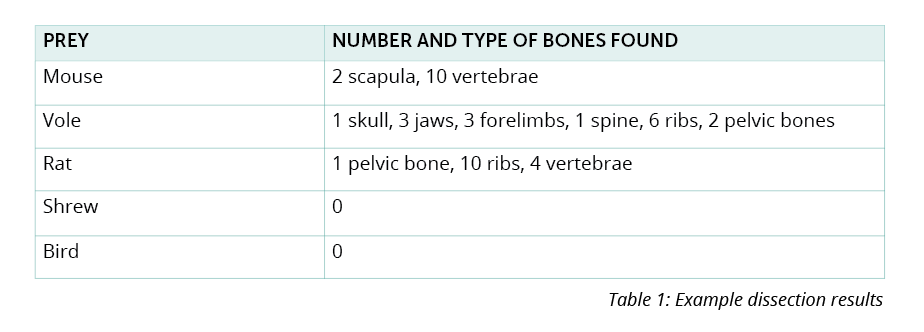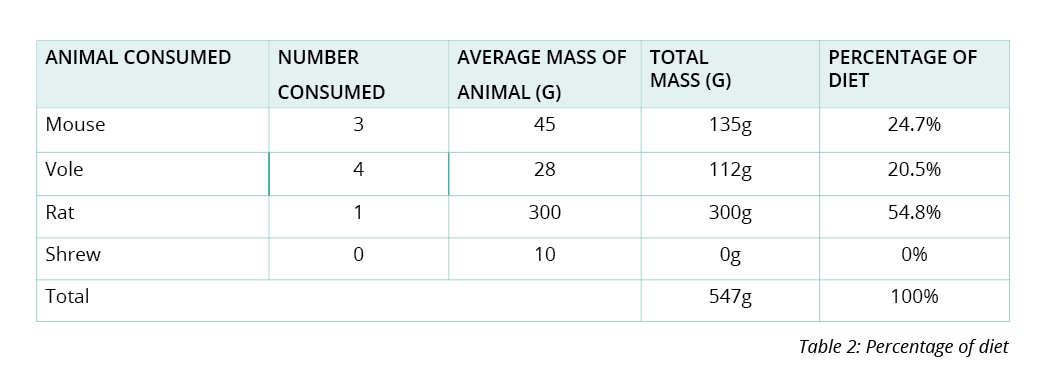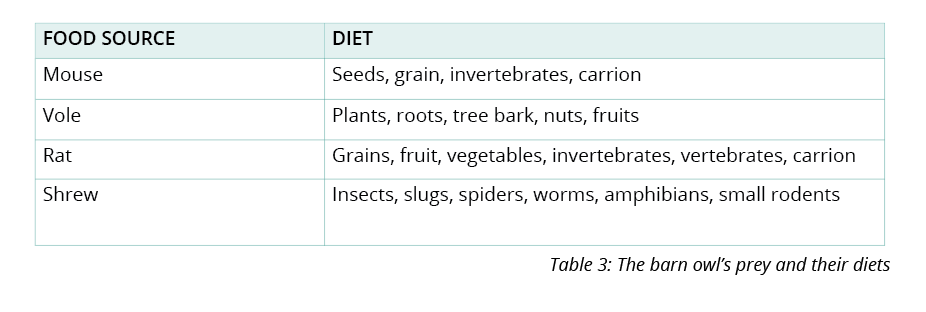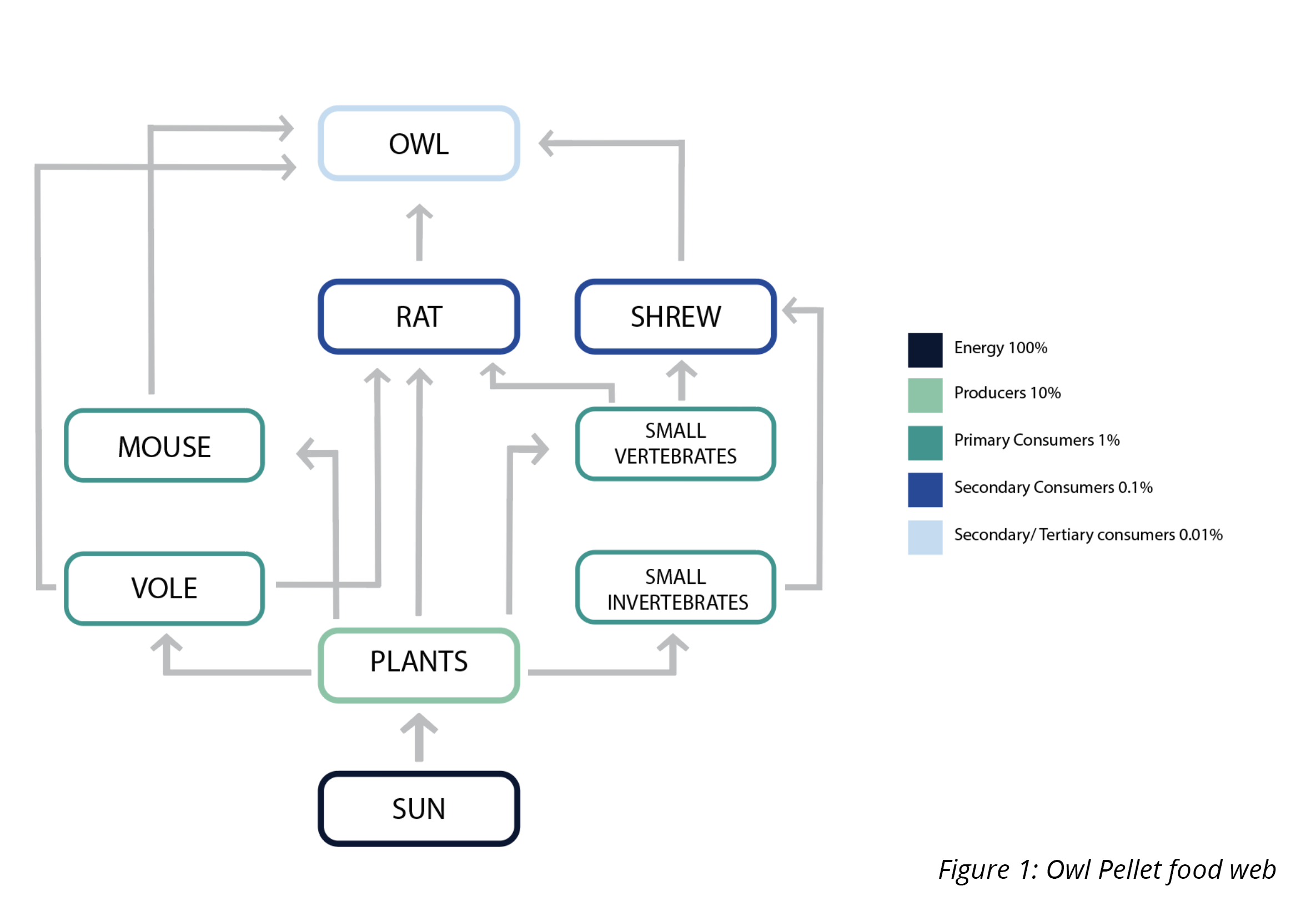Owl Pellet Food Webs

AUSTRALIAN CURRICULUM ALIGNMENT:
- Ecosystems consist of communities of interdependent organisms and abiotic components of the environment matter and energy flow through these systems
- Exploring interactions between organisms such as predator/prey, parasites, competitors, pollinators and disease
BACKGROUND:
Owls are birds of prey that hunt during night-time, and frequently swallow their catch whole. When they are not able to swallow their prey whole, it is ingested in large pieces. After it is swallowed, the prey travels down to the Owl’s stomach. Their unique stomach physiology includes the Proventriculus (the upper portion) and a Ventriculus or Gizzard (lower portion). During the first stage of digestion, the acids and enzymes within the Proventriculus partially digest the prey. The remains then travel to the Gizzard, whereby the indigestible parts of the prey; such as hair, bones, teeth, and feathers, are compressed to form a matted pellet. The pellet then re-enters the Proventriculus to remain there until the Owl regurgitates it as a pellet. Common barn Owls typically produce 1 or 2 of these pellets a day. Owls are nocturnal hunters and survive on a diet of rodents, such as Mice, Rat and Voles. Due to their hunting efficiency and ability to reduce rodent populations, some farmers intentionally attract Owls to inhabit their land by constructing artificial nests.In this practical, students study barn owl pellets look for evidence for predator–prey relationships and ecosystems. Dissecting owl pellets is the best way to learn about their diet, prey region and habitat. Their pellets can be used to determine relative numbers of small animals found in an owl’s feeding area. Students are tasked with dissecting an owl pellet and identifying the origin of the bones located within it. After counting the number and variety of prey found within their pellets, students calculate the average diet of a barn owl using the class data. Students track energy flow and biomass in owls to explore the concepts of matter and energy conservation, interdependence between organisms within ecosystems, and predator/prey relationships.
METHOD:
Barn Owl Pellet Dissection
- Unwrap your owl pellet and place it on a clean tray. Note the colour, size and texture of the pellet.
- Carefully separate the bones from the fur using wooden probes and dissecting forceps.
- Identify and categorise the bones, based on type of bone and the animal it came from. Use the Owl Pellet Bone Chart available online to do this. Mice and rats have very similar bone structures. The main difference is size. A rat will be approximately twice the size of a mouse. Use this information to tell them apart.
- Record this information in a table like Table 1.
- For the US-sourced pellets you are using, the average barn owl’s diet is approximately 50% voles, 40% mice, 5% rats and 5% shrews. Barn owls typically regurgitate two pellets a day, with each pellet generally containing four skulls. Based on the results of your dissection, determine the type and quantity of animals the owl consumed over 2 days. Gather data from another group to represent the second pellet. Using only whole numbers, record the figures in a data table like Table 2.
- To continue to fill out the table, calculate the following: a) the total mass of food consumed by the owl daily b) the percentage of mass each type of consumed prey contributes to the owl’s total daily consumption.
- Based on the assumption the owl weighs 550 g, calculate the percentage of the owl’s body weight it consumed.
OBSERVATIONS AND RESULTS
Table 1: Owl Pellet Dissection Results

Table 2: Calculating Percentage of Diet
Individual results will vary. Below is an example of expected results. Students may find bird bones within the pellet, however we recommend disregarding them from the data set, as it can be difficult to calculate the average mass of the animal as the size of birds can vary greatly depending on the species..

INVESTIGATIONS:
Using Table 3, construct a diagram of a food web (of at least five animals), with an owl at the top trophic level. Use arrows to show which organisms are consumers and which are predators. Ensure you label the trophic levels and class of consumer. Include the Sun as the energy source for plants.


- Using the information in the food web, identify the pattern in food mass consumed for the primary and secondary consumer trophic level.
- Consider how the pattern of food mass consumed for the primary and secondary consumer trophic level can be explained using the laws of conservation of matter and conservation of energy.
- Imagine what would happen if an owl consumed only rats. How would this affect the food web? Describe how the number of trophic levels and the percentage of initial energy transferred to the owl would be affected.
- Illustrate a simple food chain. The food chain should include a predator and a prey. Is the predator considered to be lower or higher on the chain?

- What is the source of the energy that enters a food chain?
- Which is more sustainable over time, an ecosystem with a single food chain or one with a food web?
- Owl pellets not only give us information about the diet of the owl, but also provide a habitat for other animals. An owl pellet is a little ecosystem all on its own. Describe the kind of organisms that are found in the owl pellet ecosystem.
TEACHER TIP:
- Continue to check student calculations throughout the activity. You may wish to provide students with a formula sheet for percentages and converting percentages into decimal numbers.
 Time Requirements
Time Requirements
- 45 mins
 Material List
Material List
 Safety Requirements
Safety Requirements
- Apron required
- Safety Gloves Required
- Safety Goggles Required
- Southern Biological Owl Pellets have been sterilised, and therefore are safe to use. They are not subject to any restrictions on use or disposal.
